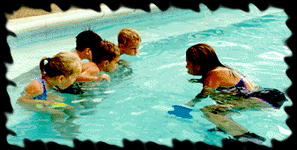
|
|

|
|

SWIMMING SAFELY
By Janice Miller, Contributing WriterSTOCKTON DESK - Swimming may be just what the doctor ordered for you and your family this summer. Children's Better Health Institute's Medical Director, Dr. Cory SerVaas taught her children and grandchildren to swim before they could walk. "Babies soak up love and what better way to show it than a lot of hugs in the water together," says Dr. SerVaas. "Learning to swim is an investment in the personal safety of your child."
Yet half of all drownings happen to children between one and four years old in home pools. In Florida, where backyard swimming pools are commonplace, drowning continues to rank first among unintentional injury deaths of young children.
Harvey Barnett, Ph.D., founder of the Infant Swimming Research Program in Winter Park, Florida, says that competency in the water is the key to safety. Unlike traditional swimming instruction for children, Barnett's program teaches them to become "aquatic problem-solvers."
Since the late 1960's, 90,000 children six months to six years old have learned aquatic safety skills from over 275 trained instructors and 1.2 million lessons. Individual, 10-minute sessions conducted during a two-week period are designed to teach a young child to survive an aquatic accident. Every baby is taught to "roll over in the water, float on his back, and breathe."
Barnett stresses that learning to be an aquatic problem-solver "does not mean that the child will seek out or create aquatic problems to solve whenever water is present . . . if the child is effectively taught not to attempt to save someone else by getting in the water, but rather to go for help in a rescue situation, the number of multiple, same-incident-site, pediatric drownings will be reduced."
Experts recommend that pool owners use every precaution to ensure the safety of their children as well as neighbors' children. Michael Shebek, Jr., president of Automatic Pool Covers, Inc. in Indianapolis advises, "Think about the layers of protection. The best safety device is adult supervision. After that, fences, covers, and cordless phones are the next important layers of protection."
Pool barrier laws vary from state to state. In Indiana, pool owners can choose one of several types of barriers including a four-sided fence with a self-closing and self-latching gate or a power safety pool cover meeting certain requirements. The latter provides a high degree of safety for children under five.
If you have or are thinking about installing a backyard pool, here are some further tips:
Keep a cellular phone on or near you at all times. Keep rescue equipment at poolside. This includes a shepherd's hook and life preserver.
Be sure to remove all toys from the pool after use. This will prevent children from trying to reach for them. Teach your child to SLIP, SLOP, SLAP the minute he or she comes out of the water [SLIP on a T-shirt, SLOP on sunscreen, SPF 15+ on children 6 months and up, and SLAP on a hat.]
Keep infants under 6 months out of the sun, and do not use sunscreen on them.
Learn CPR and take refresher courses frequently; Training is available from certified instructors at various agencies. Remember that when giving rescue breathing to an infant with a pulse, seal your lips around the infant's nose and mouth and give a breath every three seconds. If water is in the airway and air cannot get into the lungs, the Heimlich Maneuver can get the water out.
Are you thinking about enrolling your child in a swimming program? Here is a checklist to help you choose the best one for your child:
- What is the main objective of the program? Does it provide printed guidelines concerning the nature of your own participation?
- Is the program based on age-appropriate standards for your child? For instance, does the staff call your child by name? Does the staff possess current safely certifications or credentials appropriate for the activity and age of your child?
- Are swimming facilities observably clean and hygienic?
- Is the filter system regularly inspected and maintained?
- Can you get into the pool, if your child is fearful?
- What is the temperature of the water? Is it appropriate for your child?
- hat happens if your child gets chilled?
- Does the program submerge the child's head under water. If so, what technique is used? How can the program ensure your child's safely?
- Is the staff trained in injury prevention, first aid, and CPR?